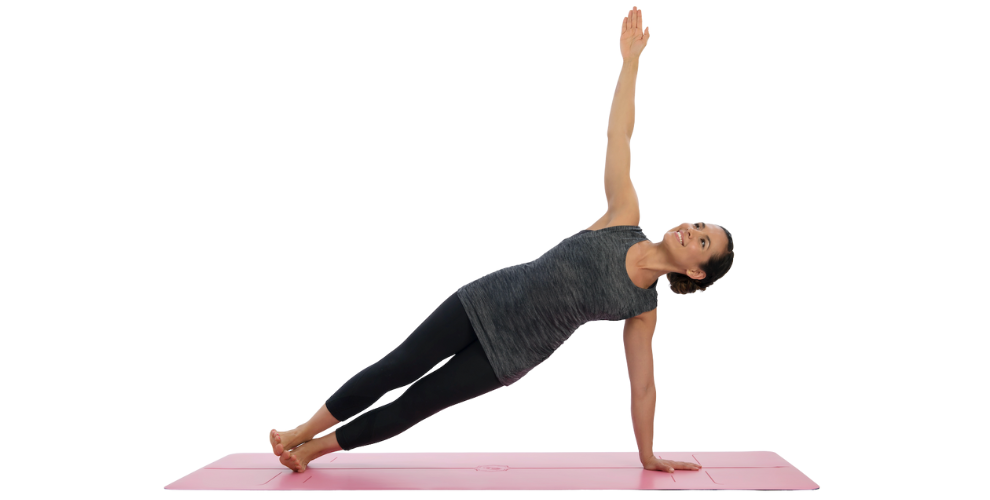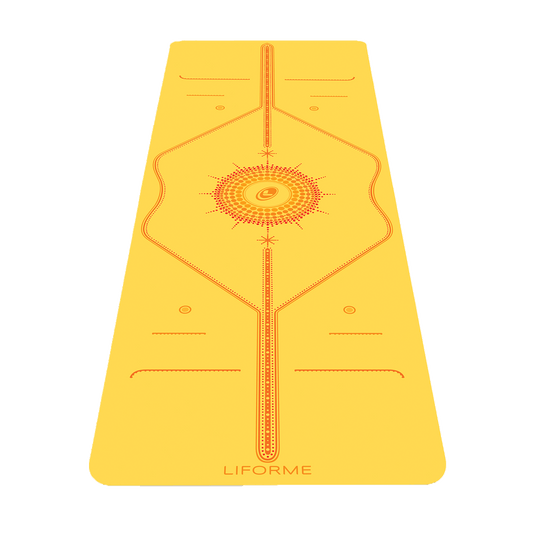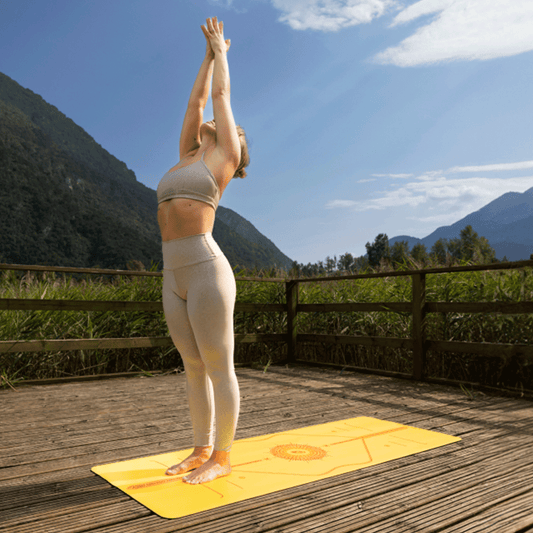We love the challenge of advanced yoga balances, but most people don’t pull up to their first yoga class ready to launch into a full King Dancer Pose. Instead, we work up to big balances by doing a lot of more accessible poses over time. Here are 15 of those postures to incorporate into your practice.
Can Yoga Help Build Balance?
Yes! The core strength, body awareness, and upper and lower body integration you get from doing yoga regularly will improve your balance tremendously, both for tricky yoga postures and healthy ageing.
While yoga’s many balancing postures (including standing poses, arm balances, and inversions) give you opportunities to practice balancing, all the other postures you do during a well-rounded yoga class are also improving your strength and flexibility in ways that support better balance.
Key Alignment Points
- Gaze and Head Position
Your head is heavy, so if you tilt it to one side or look down, it can throw you off balance. Be aware of the position of your head and your gaze in every pose.
- Hip Alignment
A tilted pelvis can really affect your balance. Get familiar with closed vs open hips in yoga and always check to make sure yours are level and facing the right direction.
- Responsive Legs
Some styles of yoga teach you to lock your knees in standing postures, but a slightly bent knee allows your body to make the continuous adjustments that contribute to better balancing.
- Wider is More Stable
If you have trouble balancing in standing poses, take your feet wider apart toward the sides of your mat for a more stable base. On the other hand, if you are looking to challenge your balance, take the feet closer together.
The Best Poses to Help Your Balance
Mountain Pose (Tadasana)
Sanskrit Meaning: Tada (Mountain)
Yoga Level: Beginner
Pose Type: Standing
Benefits: Strengthens your legs, improves body awareness
Why this pose: Many standing balances are based on the alignment of Mountain Pose, so it creates a solid foundation you can build upon.
Step-by-Step:
- Come to stand at the front of your mat with your feet touching or slightly parted.
- With your arms at your sides, turn your palms to face forward.
- Stack your joints: shoulders over pelvis over knees over ankles.
- Engage your legs and core.
- Keep your neck long and your gaze neutral.

Chair Pose (Utkatasana)
Sanskrit Meaning: Utkata (Powerful)
Yoga Level: Beginner
Pose Type: Standing
Benefits: Strengthens your legs and core
Why this pose: Another foundational standing posture and a real leg workout.
Step-by-Step:
- From Mountain Pose, bend your knees about halfway toward the floor, taking your butt back and your chest forward.
- Take your weight back into your heels.
- Lift your arms overhead. Because of the angle of your chest, they’ll be at a diagonal.

Eagle Pose (Garudasana)
Sanskrit Meaning: Garuda (Eagle)
Yoga Level: Intermediate
Pose Type: Standing Balance
Benefits: Stretches the hips, shoulders, and upper back. Improves core and leg strength.
Why this pose: Builds a balancing posture off the foundation of Chair Pose
Step-by-Step:
- From Chair Pose, lift your left leg away from the floor while keeping both hip points facing forward.
- Cross your left thigh over your right thigh.
- Hug your thighs together.
- If possible, hook your left foot around your right calf.
- Bring your hands to your hips to make sure they are still level and facing forward.
- Bing your arms out in front of you. Cross your arms with your left arm under the right.
- Bend your elbows and bring your forearms perpendicular to the floor with your palms touching if possible.

Downward Facing Dog (Adho Mukha Svanasana)
Sanskrit Meaning: Adho (Down) Mukha (Face) Svana (Dog)
Yoga Level: Beginner
Pose Type: Standing/Inversion
Benefits: Stretches and strengthens your arms, legs, core, and back.
Why this pose: While the chances that you’ll tip over in a Down Dog are minimal, there are many ways in which this posture helps your balance, including improving your body awareness and core integration.
Step-by-Step:
- From a hands and knees position, curl your toes under and lift your hips up and back to straighten your legs, bringing your body into an inverted V position.
- Release your heels towards the floor and press strongly into your hands from fingertips to palms.
- Check to make sure that your hands are equidistant from your central line. Do the same thing for your feet.
- Take your gaze to your toes.

Plank Pose
Yoga Level: Beginner
Pose Type: Arm Support
Benefits: Strengthens the arms and core.
Why this pose: One word: core. Holding a plank position requires a lot of core strength so it’s one of the best ways to build it.
Step-by-Step:
- From a hands and knees position, reach your right leg straight back with your toes tucked under and the ball of your foot on your mat.
- Take your left leg back into the same position.
- Make sure your shoulders stay directly over your wrists and your body forms a straight line from your head to your heels (meaning your butt is not sticking up).
- Draw your belly button in toward your spine and engage your glutes.
- If you can’t maintain a full plank, lower your knees to the mat but keep a straight line from your head to your knees.

Side Plank Pose (Vasisthasana)
Sanskrit meaning: Vasistha (An ancient poet and sage)
Yoga Level: Intermediate
Pose Type: Arm Support
Benefits: Strengthens the arms and core.
Why this pose: Works your obliques.
Step-by-Step:
- From Plank Pose, shift your weight onto your right hand and lift your left arm up toward the ceiling as your turn your chest to face the left side of your mat.
- Stack your left foot on top of your right foot, flexing both feet strongly.
- Lift your hips toward the ceiling.

Boat Pose (Navasana)
Sanskrit Meaning: Nava (Boat)
Yoga Level: Beginner
Pose Type: Seated
Benefits: Another way to strengthen your core.
Why this pose: A stronger core means better balance.
Step-by-Step:
- Come to sit on your mat with your knees bent.
- Hold onto the backs of your thighs as you lean your upper body backwards and lift your feet off the floor.
- Bring your shins parallel to the floor.
- Release your hold on your legs if you can do so without your upper body collapsing.
- Turn your palms upwards.
- Straighten your legs so your body forms a V shape.

Crescent Lunge (Anjaneyasana)
Sanskrit Meaning: Anjani (Hindu Goddess)
Yoga Level: Beginner
Pose Type: Kneeling
Benefits: Stretches the quads, hamstrings, and hips. Strengthens the core.
Why this pose: Not all balancing poses require you to stand on one leg. Having one leg forward and the other back requires you to use your core to stabilize yourself.
Step-by-Step:
- From Downward Facing Dog, step your right foot to the inside of your right hand and lower your left knee to your mat, taking a yoga mat pad under the knee if it is sensitive.
- Bring your hands to your hips to check that both hip points are facing forward.
- Deepen your right knee to bring your hips forward or stay more upright if you prefer.
- Take your arms overhead.

High Lunge
Yoga Level: Intermediate
Pose Type: Standing
Benefits: Stretches and strengthens the hips and legs. Improved core strength.
Why this pose: A high lunge is a deceptively difficult balance challenge. A little wobbling is normal here.
Step-by-Step:
- From Downward Facing Dog, step your right foot to the inside of your right hand.
- Come onto your fingertips, then use your core to lift your hands away from the floor and bring your torso upright.
- Take your hands to your hips to make sure your hips point are facing forward.
- Take your arms overhead.
- If you are very wobbly, try taking the feet towards the sides of your mat to create a wider base.
- Keep your right knee over your right ankle and bring your right thigh toward parallel with the floor.
- Keep your left leg straight.

Revolved Lunge Pose
Yoga Level: Intermediate
Pose Type: Standing
Benefits: Stretches and strengthens the core, hips, and legs.
Why this pose: Build on the balance challenge of a High Lunge by adding some rotation, which also works the core.
Step-by-Step:
- From High Lunge with our right leg forward, take your arms out to either side.
- Keeping your pelvis facing forward, twist to your right, bringing your left arm in front of your body and your right arm behind.
- Turn your head to the right but remember that the rotation is coming from your core, not your neck.
- Try softening the back knee if you have trouble keeping your torso upright.

Half Moon Pose (Ardha Chandrasana)
Sanskrit Meaning: Ardha (Half) Chandra (Moon)
Yoga Level: Intermediate
Pose Type: Standing
Benefits: Strengthens the arms, legs, and core. Stretches the hamstrings, chest, back, and shoulders.
Why this pose: A real workshop on integration, body awareness, and muscular activation.
- From Downward Facing Dog, step your right foot next to your right hand.
- Move your right hand forward 12-15 inches. Stay on your fingertips.
- Bring your left hand to your left hip as you straighten your right leg and lift your left leg parallel to the floor.
- Stack your left hip over your right hip and your left shoulder over your right shoulder.
- Flex through your left foot to engage your whole left leg.
- Turn your face up toward the ceiling.
- For an extra balance challenge, lift your right fingertips a few inches away from the floor.

Tree Pose (Vrksasana)
Sanskrit Meaning: Vrksa (Tree)
Yoga Level: Beginner
Pose Type: Standing Balance
Benefits: Improves leg strength, core strength, balance
Why this pose: This is the first standing balance most people tackle. It’s a good exercise in using Mountain Pose alignment.
Step-by-Step:
- From Mountain Pose, take your weight into your right leg without shifting your hips.
- Bend your left knee to lift your left foot off the floor.
- Using your hands if you need to, take the sole of your left foot to your inner right thigh, pointing your left knee to the left side of the room.
- Firm your core.
- Take your hands to your hips and confirm they are still in Mountain Pose Position.
- Lift your arms overhead.
Extended Hand-to-Big-Toe Pose (Utthita Hasta Padangustasana)
Sanskrit Meaning: Utthita (Extended) Hasta (Hand) Pada (Foot) Angusta (Toe)
Yoga Level: Intermediate
Pose Type: Standing Balance
Benefits: Strengthens your legs and core, stretches the hips, hamstrings and calves
Why this pose: Extending a leg in a standing balance requires core strength and coordination.
Step-by-Step:
- From Mountain Pose, shift your weight into your right leg while keeping your hips squared to the front of your mat.
- Lift your left foot off the floor, bending your left knee and hugging it toward your chest while continuing to stand upright.
- Reach inside your left thigh with your left hand to take your big toe in a yogi toe lock or loop a yoga strap around the ball of your left foot.
- Extend your left leg toward the front of the room, keeping your spine perpendicular to the floor. If you can’t straighten your leg while holding your toe and keeping your spine erect, bend your knee slightly or use a strap to give yourself a longer reach.
- Stay here or open your hip, taking your left leg out to the leg side.

Dancer Pose (Natarajasana)
Sanskrit Meaning: Nata (Dancer) Raja (King)
Yoga Level: Intermediate/Advanced
Pose Type: Standing Balance
Benefits: Improves leg and core strength. Stretches the abdominals, shoulders, and back.
Why this pose: Controlling your balance while back-bending is a challenge for your abs.
Step-by-Step:
- From Mountain Pose, bend your left knee and reach behind with your left hand to grab the inside or outside of your left foot (try it both ways).
- Lift your right arm up toward the ceiling.
- Begin to simultaneously tilt your torso forward and lift your left thigh toward parallel to the floor while keeping your hips square to the front of your mat. The tension between your left hand and knee begins to bring your spine into extension.
- If you can go deeper, take your left foot into the crook of your left elbow.
- For the full posture, bring the torso more upright. Reach your right arm over your right shoulder to grab your left foot. Stay there or bring your left arm over the left shoulder to hold the foot as well.

Corpse Pose (Savasana)
Sanskrit Meaning: Sava (Corpse)
Yoga Level: Beginner
Pose Type: Supine
Benefits: Rests the body
Why this pose: It’s important to balance your movement with some rest.
Step-by-Step:
- Come to lie on your back and close your eyes
- Turn your palms to face the ceiling.
- Allow your feet to turn out.
- Relax every part of your body.
- Rest with awareness for 10 minutes.
Better Balance On and Off the Mat
Balance is both a physical and a mental state. While yoga postures focus on strengthening the muscles you need to stay upright for a good many years to come, the holistic practice of yoga is also working on your mind, subtly reinforcing what’s important and reminding us to leave the rest behind. While this type of work is more difficult to measure, you’ll notice its effects as you continue to practice over time.







































